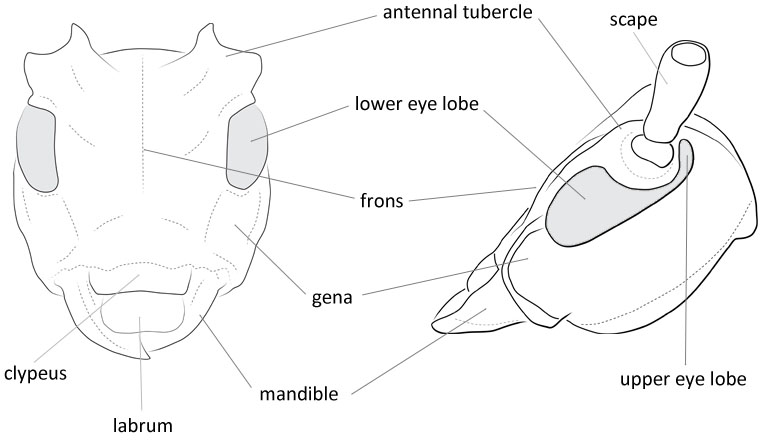Body length: 5–7 mm.
Eyes: eye interommatidial setaeseta:
a sclerotized hair-like projection of the cuticle
present, eye entire/shallowly emarginateemarginate:
notched at the margin , eye ommatidial density coarse.
, eye ommatidial density coarse.
Antennaeantenna:
in larval and adult insects, paired segmented appendages, borne one on each side of the head, functioning as sense organs and bearing a large number of sensilla
: antennal length reaching/surpassing end of body, antennal flagellar segments elongateelongate:
much longer than wide
, scapescape:
the first proximal segment of the antenna smooth/punctate at apexapex:
smooth/punctate at apexapex:
end of any structure distad to the base
, antennal segment 3 > scapescape:
the first proximal segment of the antenna .
.
Pronotumpronotum:
the upper and dorsal part of the prothorax
: pronotumpronotum:
the upper and dorsal part of the prothorax
shape longer than wide, pronotumpronotum:
the upper and dorsal part of the prothorax
lateral armature absent.
Prosternum: prosternal processprosternal process:
a posterior extension of the prosternum between the coxae dilated at apexapex:
dilated at apexapex:
end of any structure distad to the base
, procoxal cavities open posteriorly.
Elytraelytron:
the leathery forewing of beetles, serving as a covering for the hind wings, commonly meeting opposite elytron in a straight line down the middle of the dorsum in repose
: elytral length reaching or close to end of abdomen, elytral apicesapex:
end of any structure distad to the base
rounded or truncatetruncate:
cut off squarely at the tip
, elytral color pattern present.
Legs: visible tarsomerestarsomere:
subdivision or article of the tarsus, usually numbering from two to five : 4, femora clavateclavate:
: 4, femora clavateclavate:
thickening gradually toward the tip
, protibial spursprotibial spur:
sclerotized spine(s) located at the distal tibia; can be single, double, or absent : 1, tarsal clawstarsal claw:
: 1, tarsal clawstarsal claw:
usually paired claws of the pretarsus, at the distal end of the leg simple.
simple.
Form depressed; integument opaque. Antennaeantenna:
in larval and adult insects, paired segmented appendages, borne one on each side of the head, functioning as sense organs and bearing a large number of sensilla
with fourth segment a little shorter than fifth. Pronotumpronotum:
the upper and dorsal part of the prothorax
rounded at sides; prosternum with anterior coxal cavities nearly contiguouscontiguous:
so near together as to touch
. Legs with femora gradually clavateclavate:
thickening gradually toward the tip
. Abdomen with first segment as long as following 2 together (Linsley 1963Linsley 1963:
Linsley EG. 1963. The Cerambycidae of North America. Part IV. Taxonomy and Classification of the Subfamily Cerambycinae, Tribes Elaphidionini Through Rhinotragini. University of California Publications in Entomology, Vol. 21. 165 pp.).
Plectromerus
Differs from Plectromerus by first abdominal segment as long as 2+3, a matte sheen on elytraelytron:
the leathery forewing of beetles, serving as a covering for the hind wings, commonly meeting opposite elytron in a straight line down the middle of the dorsum in repose
, and the prosternal processprosternal process:
a posterior extension of the prosternum between the coxae allowing the coxae to touch.
allowing the coxae to touch.
southern Nearctic, Neotropical
broadleaf; Pinus spp.; Taxodium distichum, Juniperus sp., Cupressus; Celtis, Acer spp.
Four species. Larvae feed beneath the bark of small branches and make a broad, flat pupal cell (Craighead 1923Craighead 1923:
Craighead FC. 1923. North American Cerambycid Larvae. A classification and the biology of North American cerambycid larvae. Bulletin of the Canada Department of Agriculture (n.s.) 27: 1–239, figs 1–8, pls 1–44.).
Curius Newman, 1840